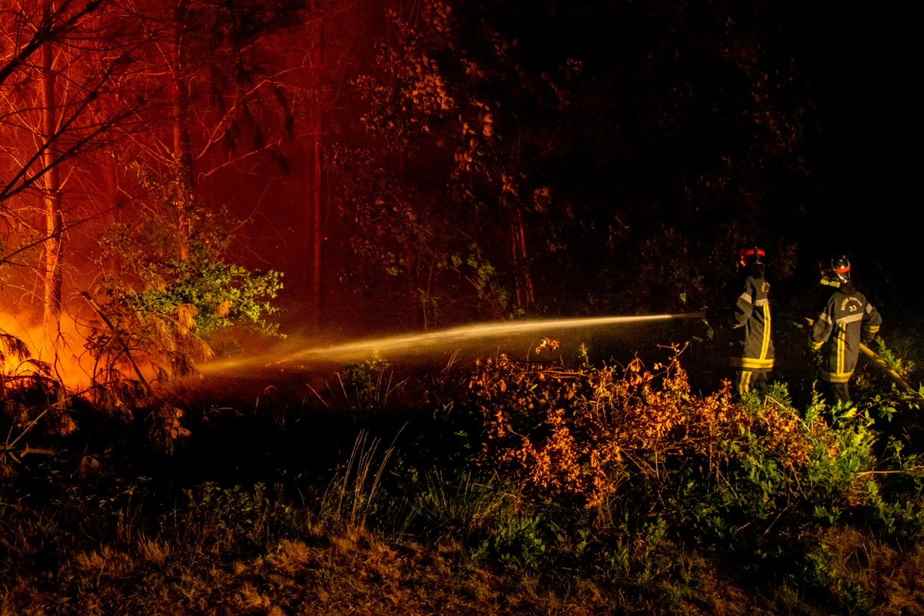(Madrid) The heat wave in Western Europe continues to cause devastating forest fires on Sunday and was expected to continue into the start of the week, where it could break several temperature records in France and Great Britain.
Posted at 7:26
Updated at 2:23 p.m.
This heat wave is the second in barely a month in Europe. The multiplication of these phenomena is a direct consequence of global warming according to scientists, with greenhouse gas emissions increasing in intensity, duration and frequency.
In France, Greece, Portugal and Spain, fires have burned thousands of hectares, forcing thousands of residents and tourists to flee their residences, and killed several members of the firefighting services last week. and relief.

PHOTO SDIS 33 VIA REUTERS
A forest fire near Landiras, in southwestern France
In the south-west of France, the mobilization of firefighters did not weaken, particularly in Gironde where nearly 11,000 hectares of forest have gone up in smoke since Tuesday, in a context of generalized heat wave. Météo-France has placed 15 departments in the west of the country on red “heat wave” vigilance, a sign of an extreme heat peak.
Monday could be one of the hottest ever recorded in France. “The heat is growing, the heat wave is spreading over the country”, warns the public meteorological establishment, which expects to see many temperature records broken, especially in the west and south-west.
Météo France recommends that the inhabitants of the areas concerned observe “absolute vigilance” in the face of “dangerous phenomena of exceptional intensity”.
“In some areas of the south-west, it will be an apocalypse of heat” which could reach 44° in places on Monday, followed by a “scorching night”, according to Météo France.

PHOTO SDIS 33 VIA REUTERS
A forest fire near Landiras, in southwestern France
For now, in the tourist area of Arcachon, on the edge of the Atlantic Ocean, the progression of the fire has slowed down, even if during the night from Saturday to Sunday “several times of fire threatened the campsites of the dune du Pilat, who had to be evacuated from their guards,” according to the Gironde prefecture.
In total, more than 14,000 residents and vacationers have had to pack their bags urgently since Tuesday.
In Lyon, the neighboring chapel of the Grand Hôtel Dieu offered refuge to tourists: “We came back to admire the place, but we can’t leave anymore, it’s too hot outside. We say a prayer before the furnace! laughs Jean-Marc, 51, who came from Alsace with his family.

PHOTO PATRICIA DE MELO MOREIRA, AGENCE FRANCE-PRESSE
A plane dumps water on a fire near Bustelo in northern Portugal.
– Up to 43.4° in Spain –
In Spain, around 20 forest fires are still raging and remain out of control in different parts of the country, from the south to the far northwest in Galicia, where the fires have so far destroyed around 4,400 hectares of land this week, according to authorities.
In the far south, a fire broke out in the Mijas mountains near the coastal city of Malaga and has so far destroyed almost 2,000 hectares, according to local authorities. It caused the evacuation of more than 3000 inhabitants, but 2000 have since been able to return to their homes.
“We worked all night” against the flames, regional agriculture minister Carmen Crespo told Spanish public television.

PHOTO ISABEL INFANTES, REUTERS
Smoke covers the sky above Garganta de los Infiernos Nature Reserve, Spain.
On Sunday, the thermometer reached 39° in Madrid, 39.7° in Seville (south), and a maximum of 43.4° in Don Benito near Badajoz (east).
Portugal was experiencing a lull: on Sunday, for the first time since July 8, temperatures there did not exceed 40 degrees, according to the national meteorological service (IPMA), after having reached a historic record for July of 47 on Thursday. °.
Calm also on the fire front: a single major focus, near Chaves in the far north of the country, was considered active and “virtually under control” over 90% of its perimeter according to Portuguese civil protection.
Nevertheless, almost all of Portuguese territory presented a “maximum”, “very high” or “high” risk to fires on Sunday, in particular the central and northern regions.
According to the latest known report from the Portuguese authorities, the fires of the last week have left two dead and around sixty injured. They have ravaged between 12,000 and 15,000 hectares of forest and brush since the start of the heat wave.
– UK red alert –
Further north in Europe, in the UK, the national weather agency has issued the first-ever ‘red’ alert for extreme heat, warning of a ‘risk to life’. The Met Office said temperatures in southern England could top 40 degrees for the first time on Monday or Tuesday.
The British government was accused on Sunday of not taking the heat wave seriously, after resigning Prime Minister Boris Johnson missed a crisis meeting on the subject in Downing Street, and his deputy Dominic Raab appeared to be delighted by for the first time over 40 degrees in England.
In the Netherlands, the Netherlands Institute for Public Health and the Environment (RIVM) announced on Sunday a National Heat Plan and a smog alert in force from Monday across the country, forecasting a rise in temperatures in the next few days, up to 35 degrees Monday in the south and up to 38 degrees in some places Tuesday.
Elsewhere in the world, extreme temperatures have also caused forest fires, notably in northern Morocco where one person died and half of the approximately 4,660 hectares affected went up in smoke, and in western Canada.
